A COMIC BOOK DEATH MATCH tie-in…

COMIC BOOK DEATH MATCH is back — and in 2024 it will be a monthly column by Fred Van Lente, comparing each issue of Marvel Super Heroes Secret Wars, which is celebrating its 40th anniversary, to DC’s Crisis on Infinite Earths. Marvel is releasing Facsimile Editions of all 12 issues monthly this year, so we’ll be timing these columns to the release dates. In this case, the Secret Wars #1 Facsimile Edition is due Wednesday, Jan. 17.
Click here to check out the kickoff installment, but Fred also has a tie-in column — fittingly, about Secret Wars tie-ins — below.
Dig it.
—
By FRED VAN LENTE
Since I have to reread all of Marvel Super Heroes Secret Wars for my COMIC BOOK DEATH MATCH column, I thought, what the heck, I’ll read all the tie-in issues too, something I hadn’t bothered to do when I was 12 and the series first came out.
I tried to do it the way we all would have in January 1984. The same month that Secret Wars #1 dropped, most regular Marvel on-goings showed their main characters entering a big Kirbytech Plot Device in Central Park’s Sheep Meadow. They vanish as a caption appears, telling readers to pick up Secret Wars and find out what happens next.

The very next month in the regular series, i.e. as Issue #2 hit the stands, the heroes came back after Secret Wars was over, about a week later in story-time, often significantly altered. If you wanted to learn why and how those changes happened, you had to keep reading Secret Wars, which was coming out at the same time, now with an epic story set in the heroes’ recent past.
Having worked in the funnybook factory for as long as I have, I cannot even begin to tell you how utterly bananas it is to do a big crossover event like this, and what a nightmare of coordination it would require today.
At the time, though, Jim Shooter, Marvel’s editor-in-chief, was running the Secret Wars event, ostensibly to promote the new Mattel action figure line of the same name, and he had the authority to ram this all throu—uh, make it happen.
I am ashamed to admit it tickles me greatly to think about how annoyed Marvel’s regular creative teams must have been when their boss told them to go along with this kooky plan. Many inanimate objects were hurled against walls, I guarantee.
Reading the tie-ins with fresh eyes, though, I was struck by how many big changes did in fact happen to the regular Marvel Universe as a result of Secret Wars, and wrote them down in order of importance to see if you agree. Enjoy!
—
13 (TIE). Literally Nothing (Captain America #293 & Marvel Team-Up #141). The No-Crossover-Fucks-To-Give Award goes to the Captain America creative team of J.M. DeMatteis and Paul Neary, who give airtime to the aftermath of Secret Wars in a single exchange of dialogue between Cap and his sidekick:
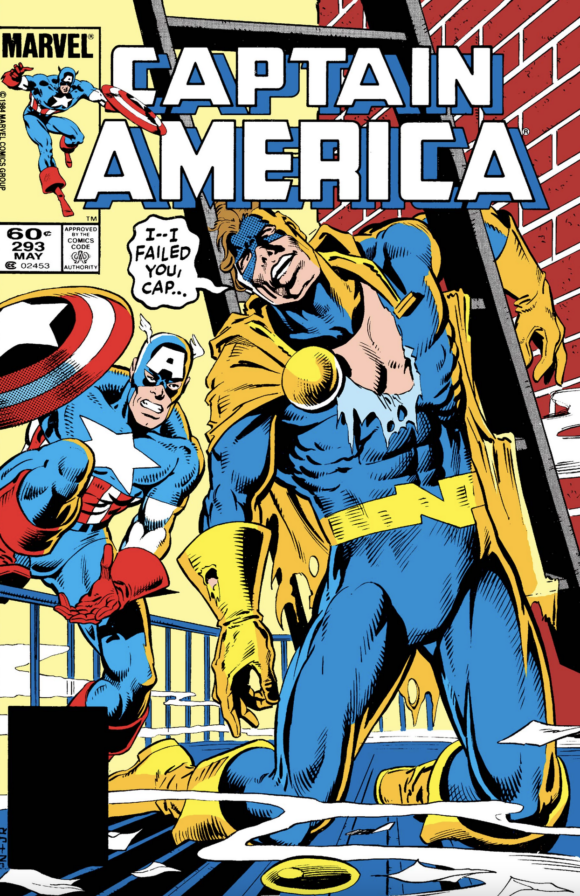
Nomad: You mean you and all the Avengers and were just swept off to another planet, just like that?
Cap: Me, the Avengers, and a good percentage of Earth’s heroes and villains! But I really don’t want to talk about that, Nomad!
Geez, Steve, why are you getting so pissy? You clearly brought it up first!
The follow-up disappointment has to be Marvel Team-Up #141 (from Jim Owsley, a.k.a. Christopher Priest, working off a Tom De Falco plot, with Milleresque art from Greg LaRocque and Mike Esposito), because of the failed opportunity to have Daredevil be the first person to instantly recognize Spider-Man in the black costume, since his super-senses aren’t fooled by appearance. Instead, some random thug does it out of nowhere. Phooey!
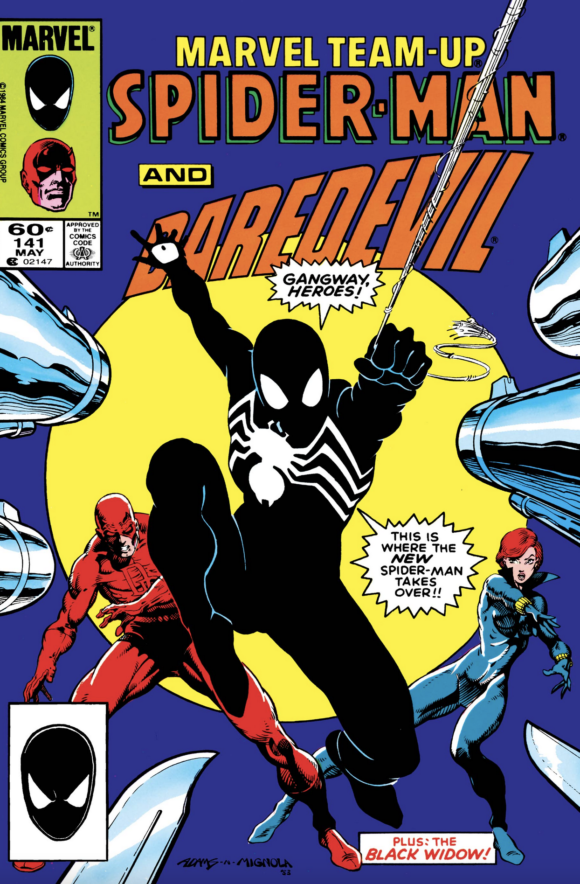
—
12. We Temporarily Stop Caring Who the Hobgoblin Is (Amazing Spider-Man #251). Peter Parker has been on the receiving end of some deeply divisive storylines over the years: The Clone Saga, One More Day, et al. The big disappointment for Spider-Fans of the 1980s was the constant bait-and-switch over the true identity of the Hobgoblin. Secret Wars begins right at the end of this ish, a pretty good installment of the Tom De Falco era (plot by Hobby co-creator Roger Stern) with fantastic Klaus Janson finishes over Ron Frenz layouts.

The cover notwithstanding, though, this story is neither an unmasking of nor an ending to the Hobgoblin saga. There’s a great fight, but at the end of it, Hobby gets away, sans mask, identity protected. Peter gets a win because he destroys the blackmail evidence Hobby had against various prominent New Yorkers, including Harry Osborn. The villain had the journals of Harry’s dad Norman, whom Hobs threatened to expose as the original Green Goblin. Peter gives Harry an anti-Goblin pep talk in Central Park (which sadly does not stick) before getting a super-duper Spidey-Sense blast that sends him to the Beyonder’s Plot Device.
Frenz and Janson give us the best shot of all the tie-ins at this nonsensical Kirbytech “Stonehenge” that whisks everyone off to Battleworld:

But the Hobgoblin storyline continues limping along until it finally gets resolved to the satisfaction of almost no one. Beyonder, we could have used your cosmic powers to fix this one.
—
11. The Enchantress Finds, and Loses, True Love (Thor #383). Walt Simonson’s sole crossover contribution as the writer/artist of Thor is to have Goldilocks disappear into Avengers Mansion in the issue before #1’s arrival. Walt says, basically, go pick up Secret Wars if you care about any of this Battleworld stuff, I am just gonna go on being awesome. And he did.
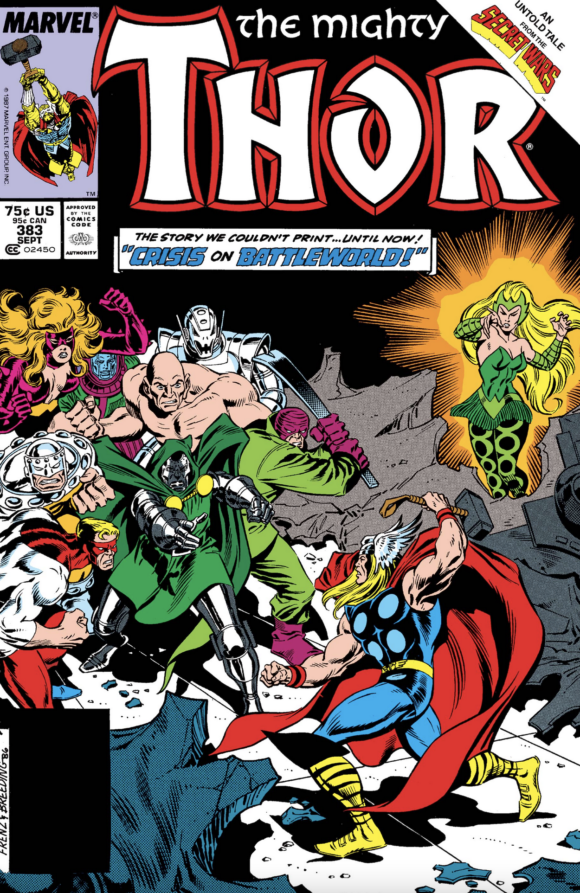 3
3
But Thor wasn’t the only Asgardian to be whisked away by the Beyonder. It’d take a few years for anything to come of it, in a De Falco/Frenz joint in 1987. This fill-in-feeling issue involves Enchantress womansplaining to her sister Lorelei how she fell hard for Thor back on ol’ Battleworld then screwed it all up. Therefore, Lorelei shouldn’t make the same mistakes by treating her suitors badly (like turning them to stone). Amora’s unrequited love for Thor would be an on-and-off element in the series for a while.
—
10. Black Cat Discovers Her Powers (Peter Parker, the Spectacular Spider-Man #90). Felicia Hardy is a fun character I enjoyed writing quite a bit. Here, her primary developer, writer/artist Al Milgrom, takes her on a romp through New York trying to find where sometimes-boyfriend Spider-Man’s disappeared to. All the while, she’s debating whether or not to tell him she got “bad luck” super powers from the Kingpin’s crack scientific team. (I wonder if John Gotti would have lasted longer if he had an R&D division.)
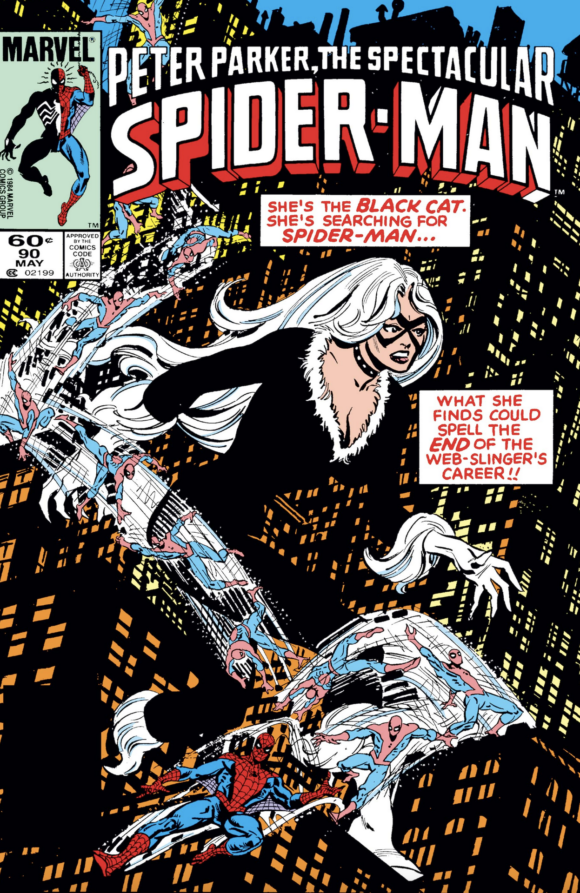
This is one of the better Secret Wars tie-ins. One of the places Black Cat breaks into looking for clues is Avengers Mansion. She’s promptly captured by the building’s defenses, but rather than turn her over to the cops, Vision and the Scarlet Witch offer her membership, seeing how most of the other heroes have disappeared. The regular Assemblers return before the ranks have to be expanded to include backbenchers like Felicia, but her on the team is an interesting idea you’d hope other creators would explore more.
—
9. Wolverine Adopts a Daughter (Uncanny X-Men #181). Spidey isn’t the only Secret Wars participant who returns from Battleworld with an ET pal. Lockheed comes back with a giant alien dragon stalker, who promptly starts trashing Tokyo, requiring some merry mutant intervention, as depicted by Chris Claremont and John Romita Jr.
Professor X and crew agree it’s odd they were returned back to Earth in Japan, not New York, where they left, but it is not explained—nor is Cyclops’ mysterious reappearance next to Madeline Pryor in their honeymoon hotel in Tahiti. The palpable lack of effort put into integrating Secret Wars with Marvel’s flagship title is hilarious.
A young mother is slain by falling dragon wreckage in the general vicinity of Wolverine. Being that kind of guy, Wolvie takes the woman’s bawling daughter and swears on his honor as a Canadian Samurai that, “I’ll see she’s raised as if she were my own. You have my word.”
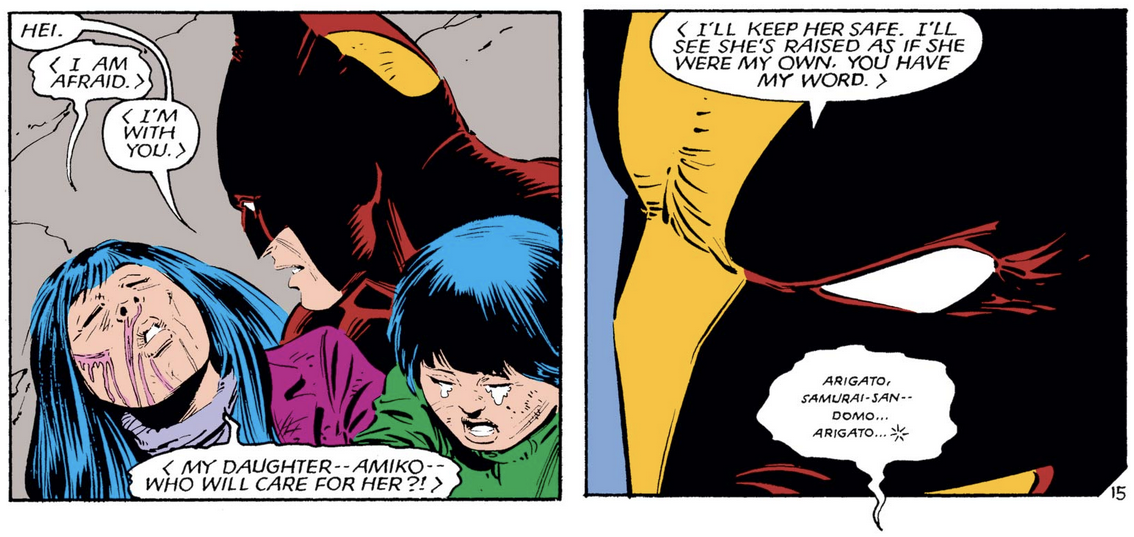
He then promptly dumps the kid, Amiko, onto his girlfriend to raise, off-panel, and goes on his merry way.
I’m not saying you shouldn’t trust Wolverine at his word, but I wouldn’t lend this guy my car, or 20 bucks, much less my toddler.
—
8. Rocky Grimm, Space Ranger! (The Thing #11-22). As you can see, most Marvel creative teams tried to insert Secret Wars into their storylines while leaving no trace on the rice paper, as the kids say.
Not so the gang over at The Thing (writer John Byrne and penciller Ron Wilson, at first) who went all-in. Ben Grimm sticks around on Battleworld after all the other heroes leave for a whole year’s worth of Secret Wars sequel adventures that come out at the exact same time as the original series, which is in itself, uh, completely insane.
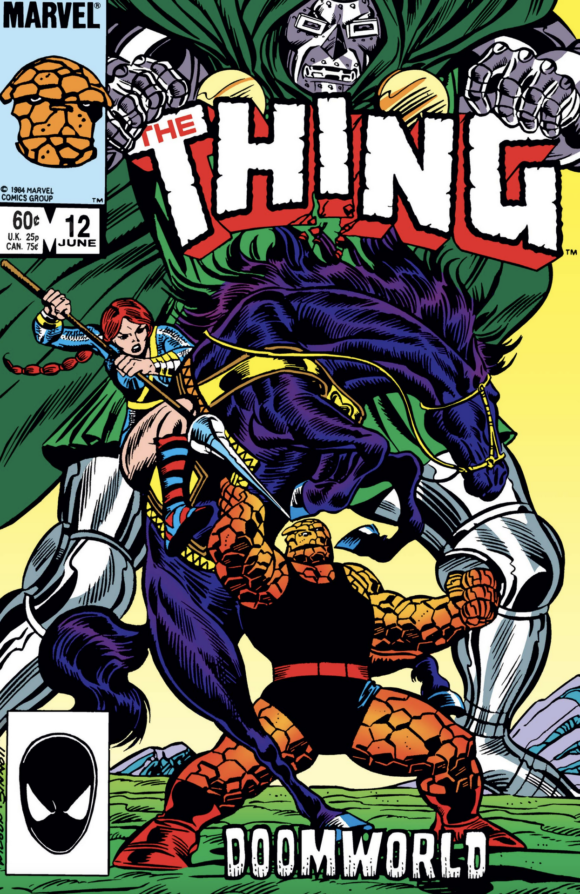
That said, it’s not like anyone actually missed Ben much, since his departure enabled #4 on this list, but that’s why it’s noteworthy.
—
7. Smart Hulk Gets Dumber (Incredible Hulk #295). Secret Wars is wedged awkwardly into the middle of a multi-issue storyline in the legendarily long and fantastic run of Bill Mantlo and Sal Buscema. Bruce Banner has had Hulk’s body but his own brain for a while now. He’s using his smarts to cure people of cancer with gamma rays. But he won’t cure a New York mob boss, so the don hires Boomerang—the answer to the question “What character least suited to be a Hulk villain was created to be a Hulk villain?”—to kidnap his gal pal Kate Waynesboro (yes, the future Ms MODOK) until Banner changes his mind. Hulk comes to New York to rescue her, only to be zapped into the Plot Device instead.
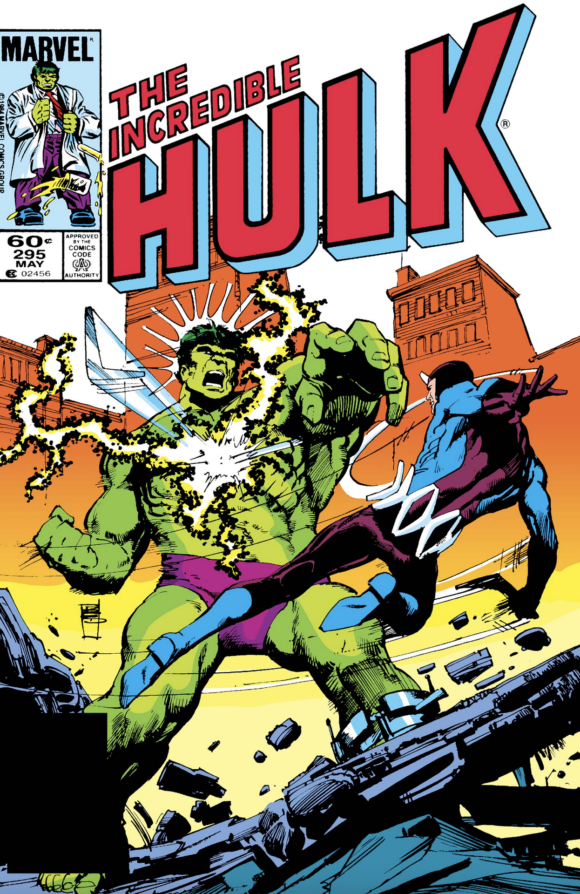
Now, over a week later, Hulk is back, using a piece of Battleworld wreckage like a crutch, having broken his leg somehow—“But how?!” fans are supposed to breathlessly ask for the next 10 months—and is ready to pick up this storyline exactly where he left off.
Hulk wails the tar out of Boomerang one-legged, then learns, to no one’s shock but his own, that his radiation treatments turn cancer patients into angry Hulks.
We may have overestimated Smart Hulk’s smarts.
These various events begin Hulk’s cognitive decline before he turns totally savage again. Dr. Strange has to banish him to a multidimensional crossroads in Hulk #300.
—
6. White Queen Captures Kitty Pryde (Uncanny X-Men #180/New Mutants #15-17). So if this were a TOP 14, “Colossus finds an alien girlfriend on Battleworld” would have made this list. But the will-they-or-won’t-they between him and Kitty Pryde was already leaning heavily toward won’t-they because of her feelings for the more age-appropriate Doug Ramsey. (Ergo, the alien girlfriend is more of a consequence of this.)
In this ish (also by Claremont and Romita the Younger), Doug has gotten an invitation to tour a school Kitty knows to be run by the Hellfire Club, and she wants to go with him for protection. The X-gang agrees to this plan because she’ll be in telepathic contact with Professor X the whole time. What could go wrong?
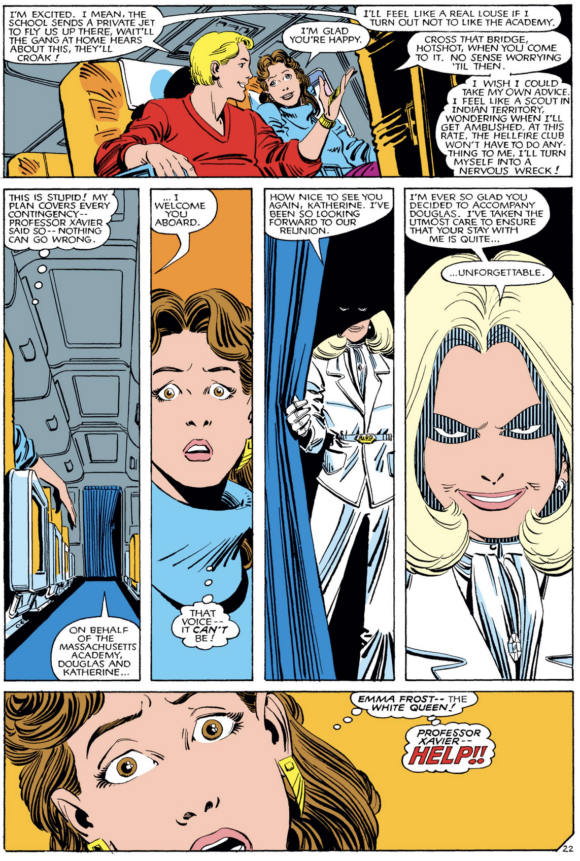
Well, villainous Emma Frost decides to make her presence known on the private jet flying the kids from LaGuardia to Massachusetts. (The Hellfire Club could give fuck-all about their carbon footprint!) Kitty sends out a frantic telepathic distress call to Prof X just as he and the rest of the team disappear into the Plot Device in Central Park. Oops!
In the X-ers’ absence, the New Mutants take a Greyhound bus to rescue Kitty and Doug and throw down with the (premiering) Hellions. Using public transportation, that’s how you know who the real heroes are.
—
5. The West Coast Avengers are Founded (The Avengers #243). When the marquee Assemblers vanish into the Plot Device, the Vision takes charge of the survivors. After Cap & Co. return a week later, current chair Wasp is so impressed by the job he did that she nominates him to take over her leadership role permanently.
Of course, no one at the time realizes that the Vision is being secretly manipulated by the Titan world-computer ISAAC to conquer Earth, in what I declared in another column to be the best storyline of Roger Stern’s title-defining run.
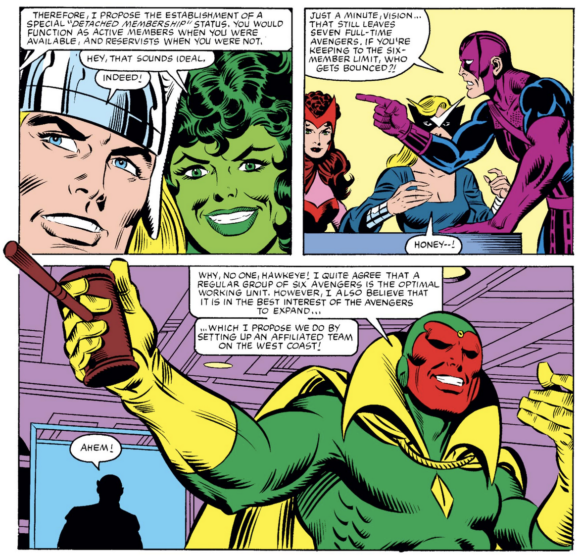
The first thing Vizh does after getting the Avengers chairmanship post-Secret Wars is start a West Coast division and orders Hawkeye to lead it. Did the massive Plot Device that whisked away all the heroes materialize in LA? San Francisco? Vancouver? No, it did not. Spreading your heroes out across the continent seems a smart way to stymie future cosmic kidnappings.
—
4. She-Hulk Joins the FF (Fantastic Four #265). There are two stories in this issue, the first one being a very fun POV comic in which the Trapster breaks into the Baxter Building in the FF’s absence, only to run afoul of the BB’s automated defenses. This is the kind of formalist experiment writer/artist John Byrne excels at (q.v. “Snowblind” in Alpha Flight #6).
The second tale depicts what pregnant Sue Storm has been up to since her family got zapped away in Central Park for over a week. (In short: Not much.) Upon the heroes’ return, Sue discovers that the Thing has chosen not to return from Battleworld with everyone else, and She-Hulk has taken his place.
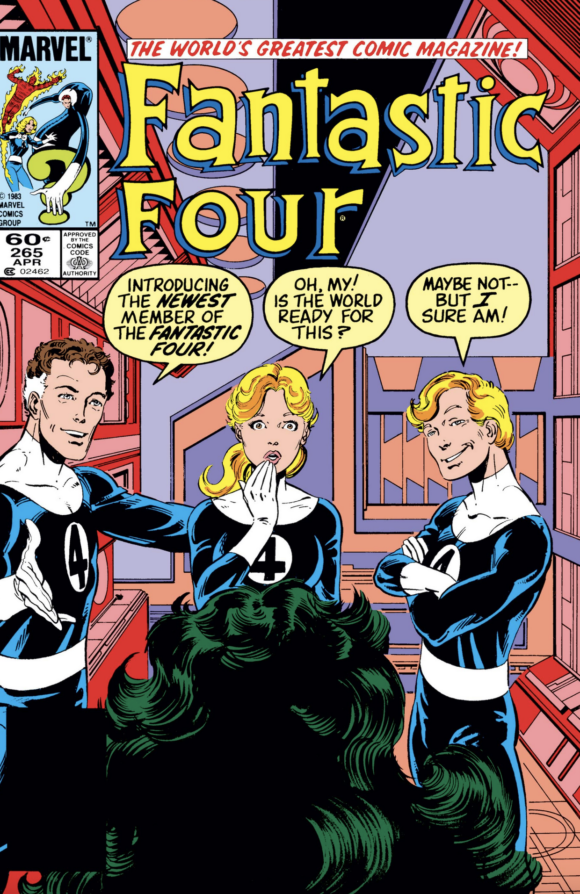
She-Hulk would be a member of the FF for the rest of Byrne’s terrific run, and is generally agreed to be the best replacement Fantasticker since the original four, thanks primarily, I’d say, to her refreshingly positive attitude. Jennifer Walters is the rare Marvel character who actively enjoys being a superhero.
—
3. Tony Stark Sobers Up (Iron Man #182). Boy, mainstream comics were schizophrenic in the early 1980s. Over in Secret Wars, Jim Rhodes, current inhabitant of the Iron Man armor, is trying to sell Freedom Fighter Bases to 10-year-olds. Meanwhile, back in his regular comic, the OG Shellhead, Tony Stark, now a disgraced, homeless alcoholic, pawns his overcoat for 10 dollars and buys a bottle of booze for the express purpose of drinking himself to death.
Comics! They’re not just for trauma—I mean, kids, anymore!
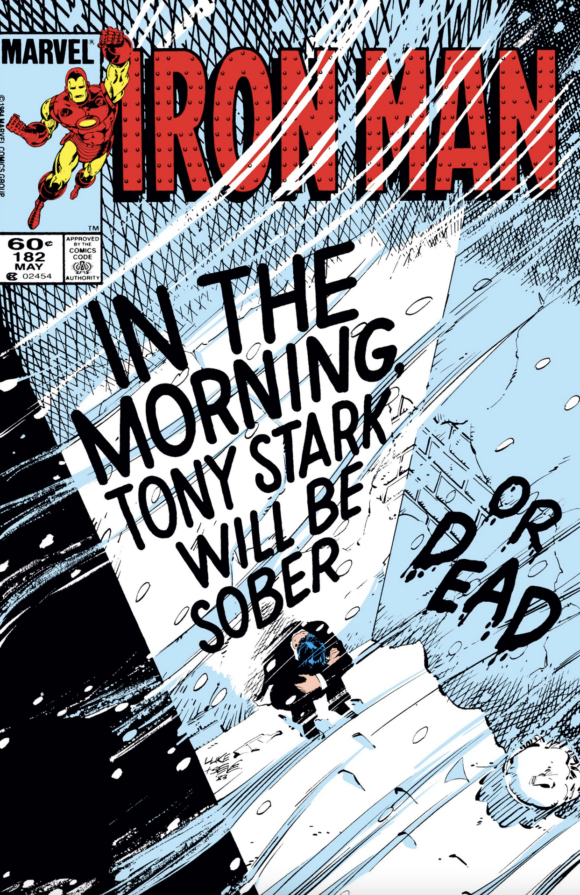
Stark’s suicide attempt is thwarted by him needing to deliver a fellow homeless woman’s baby. The mother dies in childbirth, but Tony uses his lingering body warmth to keep the child safe. Stark is still in the hospital, frostbitten hands wrapped in bandages, when Rhodey returns from Battleworld to learn that his friend has decided to kick the bottle and start a new chapter of life.
Though Rhodes’ disappearance isn’t really Stark’s inspiration to try and Leaving Las Vegas himself, there’s something metaphorically apt about Iron Man’s inaccessibility obliging the all-too-human Tony to figure his shit out. This could all be super corny, but in the deft hands of Denny O’Neil (the gritty street-level urban milieu reads to me like a dry run for his incredible Question series) and Suicide Squad MVP Luke McDonnell, this tale is surprisingly moving and still holds up today, even with Battleworld shenanigans grafted onto it.
—
2.) Spider-Man Gets a Symbiote Costume (Amazing Spider-Man #252). Recently, the guy who cuts my hair—who knows what I do for a living—asked me what the difference between the black-costume Spider-Man and regular-costume Spider-Man was. He assumed it was a completely different character in the vein of a Miles Morales, but I was able to regale him with the whole story from the symbiote getting pooped out in ball form in Secret Wars all the way through the first appearance of Venom, thereby killing a solid 10 minutes of snip-snip time.
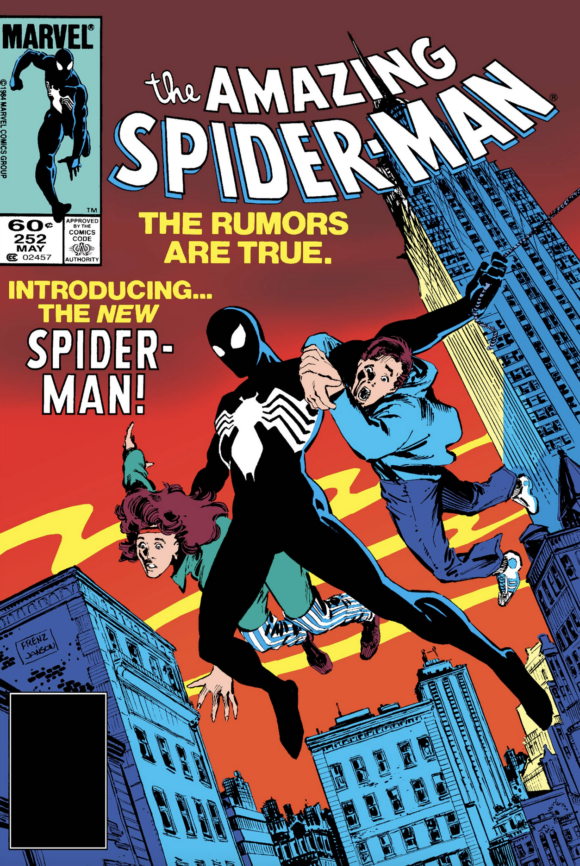
The issue that introduces that costume first, by Tom De Falco with excellent art by Brett Breeding over Ron Frenz, is mostly continuity book-keeping. (It’s also available as a Facsimile Edition this Wednesday.) Spidey comes back to Central Park post-Secret Wars with a de-Lizarded Curt Connors, whom he returns home. He develops all the pictures he took on Battleworld but destroys them, believing no one would think they’re real anyway. (Coyly ensuring No Spoilers for the still-on-going event.) He then goes out on patrol in his new costume, and kidnaps a bickering couple and tries to convince them how great New York City is.
I’m not surprised I forgot about that last part when I was explaining the story to my barber.
—
1.) The Last Major Mainstream American Superhero Comic Aimed Squarely at Kids (Marvel Super Hero Secret Wars #1-12). Reading the grim Iron Man #182 in the middle of this big event to sell toys made me realize I was very much looking at a changing of the guard.
When I was 12, I bought Secret Wars right off the spinner rack in my local drugstore. Mine is probably the last generation to do that. The nearest comics shop to the small town in Ohio where I lived was 40 minutes away by car and it wasn’t until I got a driver’s license that I got into the Wednesday habit.
Superhero comics didn’t so much abandon kids as get herded toward an older readership due to market forces largely out of their control. The newsstand was dying for reasons that had nothing to do with comics. Sales were steadier in comics shops, where the readership skewed older. Watchmen would come out a couple years later, and revolutionize readers’ and creators’ attitudes toward a genre that had originally been invented solely to entertain children. The energy of writers and artists, who of course hungered for mainstream acceptance, moved away from “kids’ stuff” to material they could share with their peers.
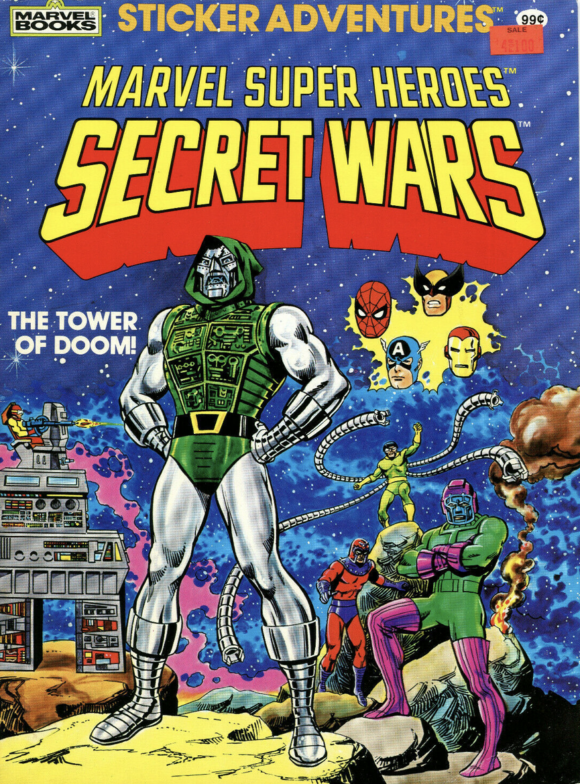
I cut my teeth as a professional comics writer in the mid-aughts on the Marvel Adventures line, kid-friendly escapades of Spider-Man, the Fantastic Four, and the like, created solely to meet the strict content standards of the Walmarts of the world so they could be sold there. (Iron Man #182, 20 years old by that point, would have been banned, banned, banned.)
Any new toy line that needed a comic to promote it these days would be set in its own pocket universe, Marvel Adventures-style, far, far away from the mainline 616, so adult fans wouldn’t decry their titles were being diluted by kiddie stuff—and kids wouldn’t be horrified by, say, frank depictions of alcoholism.
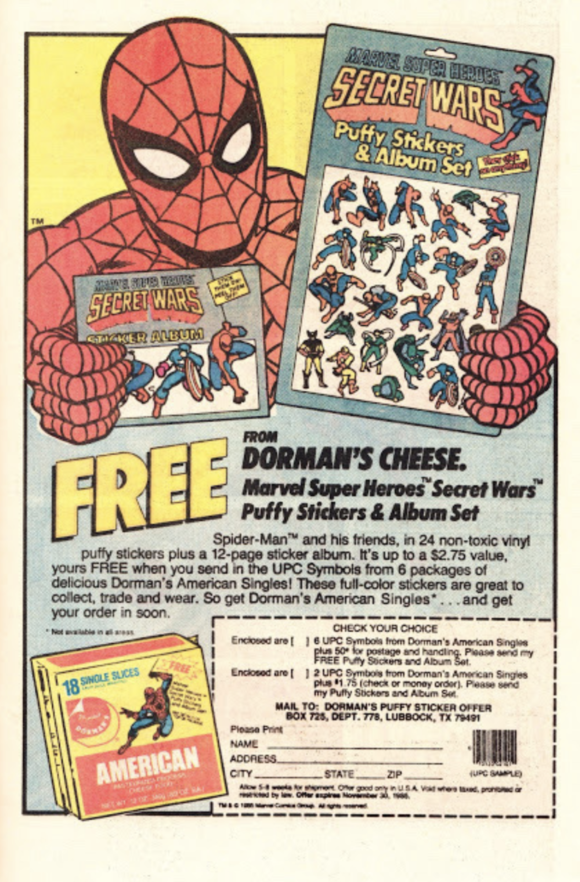
(In fact, also in 1984, DC released a massive “crossover” of their major heroes and villains to sell toys, and did exactly that: The Super Powers mini-series, spearheaded by none other than the legendary Jack Kirby, was completely separated from mainline continuity. Though the DC toys trounced the Marvel line, when it comes to comics, there’s simply no comparison.)
I’m not saying this is a good or a bad thing, only pointing out that that is how the genre and medium evolved. Though heralded as the first big “event” book, in many, more significant ways, Marvel Super Hero Secret Wars was actually the last of its kind.
—
MORE
— COMIC BOOK DEATH MATCH: Secret Wars #1 vs. Crisis on Infinite Earths #1. Click here.
— The Complete COMIC BOOK DEATH MATCH Index. Click here.
—
13th Dimension contributor Fred Van Lente is an award-winning, New York Times-bestselling comics writer, as well as an occasional novelist, teacher, and playwright. Sign up for updates on his upcoming projects and check out the trailer for his comics-writing course at his web site, fredvanlente.com.

January 13, 2024
I was ten years old when Secret Wars came out, and I loved it. It was only years later that I’d see a lot of online reviews and YouTube videos of the series, and it seemed to get a lot of hate and ridicule. I wasn’t even aware of the toys aspect because they didn’t sell them here in New Zealand. I got Kenner Superpowers figures for Christmas instead, although I’d never read a DC comic in my life (I loved the figures though and still have them).
Unfortunately, out here in New Zealand at the time, you had to take your chances finding the Secret Wars issues. If someone got to the couple that were put on the shelves in that one store you knew stocked them first, you were out of luck. It wasn’t until decades later that I picked up the collected and then digital editions, and I could finally read the three issues I never found as a kid. Admittedly, I developed a great dislike for the pining/cheating on his girlfriend Colossus storyline that must have gone over my head as a kid, but I still enjoyed the re-read.
And thanks for posting that Tower of Doom sticker cover. I’d completely forgotten I had that as a kid! Great memories were stirred up by a great article. Thanks 🙂
January 13, 2024
Despite the gems posted by Mr. Kupperberg and sometimes Mr. Levitz, this is the kind of clickbait schlock this site has devolved into repeating regularly. This used to be a classic comic paradise. Too bad, because this had some really great content but lately, not so much.
January 14, 2024
OK
January 13, 2024
I remember when FF 265 came out. Loved when She-Hulk joined.
January 18, 2024
FYI – Super Powers was not “completely separated from mainline continuity.” Volume 1 fits in easily and refers to events that had recently occurred in other DC titles. Volume 2 follows directly from New Gods 6 and the Hunger Dogs Graphic Novel. Volume 3 ends with Darkseid back on Apokolips where we find him in Crisis on Infinite Earths. The Stargate, introduced in Volume 2, continues to be utilized post-Crisis. Legends 1 begins with Darkseid reflecting on his battles with the heroes of Earth, several of whom he had not encountered except in the Super Powers stories (Captain Marvel, Martian Manhunter, etc.) The Hunger Dogs also continues to be mentioned for some time in DC titles.
January 18, 2024
Because I’m me, and of course I have both SUPER POWERS mini-series in a longbox under my desk, I got out #1 (cover-dated July 1984) and I’ve got to say the text does not support your assertion, my friend. No reference is made to any pre-existing DC continuity. It could have easily been a “DC Adventures”.
January 18, 2024
Sorry, but you’re wrong. The first issue of volume one refers to the death of Luthor’s wife and son and the destruction of his planet in Action Comics 544. Incidentally, that issue was also the first appearance of the “new look” for Luthor and Brainiac, usually associated with Super Powers. In issue two, Superman refers to Batman recently leaving the JLA when he hears his “now-defunct emergency JLA frequency.” It’s also worth noting that the Worlogog device that appears in issue 5 reappears in the “Rock of Ages” Darkseid story in Morrison’s JLA run. The references are admittedly few, but present.